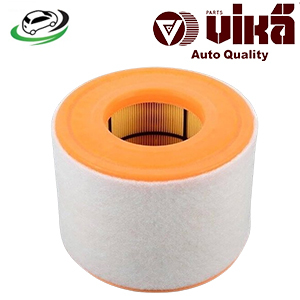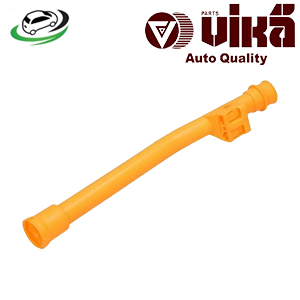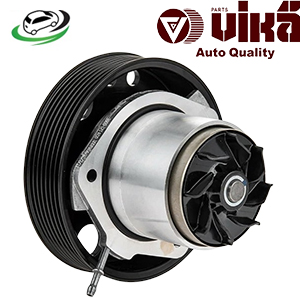-14%
Get Engine Water Pump VW TOUAREG-3.6L 2011-2012 03H121008B
The cooling water pump, also known simply as the water pump, is a critical component in a vehicle’s cooling system. Its primary function is to circulate coolant through the engine block, cylinder head, radiator, and heater core to remove heat from the engine. This detailed overview will cover the construction, function, benefits, common issues, signs of failure, and maintenance of a cooling water pump.
Construction and Function of a Cooling Water Pump
Construction:
- Housing:
- Material: Typically made from cast aluminum, cast iron, or plastic for durability and heat resistance.
- Design: The housing contains the impeller and forms part of the coolant pathway, with inlet and outlet ports for coolant flow.
- Impeller:
- Material: Often made from metal or high-strength plastic.
- Function: The impeller is a rotor with blades that spins to propel the coolant through the system.
- Shaft and Bearing Assembly:
- Shaft: Connects the impeller to the pulley or drive mechanism.
- Bearings: Support the shaft and allow it to spin smoothly, reducing friction and wear.
- Pulley or Drive Mechanism:
- Belt-Driven: Many water pumps are driven by a belt connected to the crankshaft.
- Timing Belt or Chain: In some engines, the water pump is driven by the timing belt or chain.
- Seal:
- Function: Prevents coolant from leaking out along the shaft.
- Material: Typically made from high-quality rubber or silicone.
Function:
- Coolant Circulation:
- Pump Action: The impeller spins, creating centrifugal force that propels the coolant through the engine and radiator.
- Heat Transfer: The circulating coolant absorbs heat from the engine and releases it through the radiator.
- Temperature Regulation:
- Maintains Optimal Temperature: By continuously circulating coolant, the water pump helps maintain the engine at an optimal operating temperature.
- Prevents Overheating: Efficient coolant flow prevents the engine from overheating, which can cause serious damage.
- Component Integration:
- Interconnects System: Connects various parts of the cooling system, including the radiator, heater core, and engine block.
Benefits of a Cooling Water Pump
- Efficient Heat Dissipation:
- Consistent Cooling: Ensures a steady flow of coolant to remove heat from the engine, maintaining optimal performance.
- Prevents Overheating: Critical in preventing the engine from overheating, which can lead to catastrophic engine failure.
- Improved Engine Longevity:
- Reduces Wear: By keeping the engine temperature within the ideal range, it reduces wear and tear on engine components.
- Protects Engine: Prevents thermal stress that can cause cracks and other damage to engine parts.
- Enhanced Performance:
- Optimal Temperature: Helps the engine run efficiently by maintaining a stable temperature, improving fuel efficiency and power output.
- Stable Operation: Contributes to smooth engine operation and performance.
- Reliability and Durability:
- Long-Lasting: High-quality water pumps are designed to last for many years and miles of driving.
- Robust Design: Built to withstand the harsh conditions of the engine compartment, including high temperatures and pressures.
- Maintenance of Other Systems:
- Supports HVAC: Proper coolant flow ensures the heater core functions correctly, providing heat for the cabin.
- Prevents Coolant Loss: Seals and bearings help prevent coolant leaks, maintaining system integrity.
Common Issues with Cooling Water Pumps
- Leakage:
- Seal Failure: The most common issue is seal failure, which can lead to coolant leaks.
- Housing Cracks: Cracks in the pump housing can also cause leaks.
- Bearing Failure:
- Wear and Tear: Bearings can wear out over time, causing the shaft to wobble and eventually fail.
- Noise: Failing bearings often produce a whining or grinding noise.
- Impeller Damage:
- Corrosion: Impellers can corrode, especially if the coolant is not maintained properly.
- Breakage: Impellers can break or crack, reducing the pump’s efficiency.
- Belt Issues:
- Belt Wear: The belt driving the pump can wear out, become loose, or break, stopping the pump from working.
- Misalignment: Misalignment of the belt can cause uneven wear and reduce the lifespan of the pump.
- Overheating:
- Reduced Flow: Any damage or obstruction to the impeller can reduce coolant flow, leading to overheating.
- Blockages: Blockages in the cooling system can prevent proper coolant circulation.
Signs of a Failing Cooling Water Pump
- Coolant Leaks:
- Visible Puddles: Puddles of coolant under the vehicle can indicate a leak from the water pump.
- Coolant on Engine: Coolant may be visible on the engine or around the water pump.
- Overheating Engine:
- Temperature Gauge: The temperature gauge on the dashboard may show a higher than normal reading.
- Warning Light: The engine temperature warning light may illuminate.
- Unusual Noises:
- Whining or Grinding: A failing water pump often makes whining, grinding, or groaning noises, especially when the engine is running.
- Squeaking: Squeaking noises can indicate a loose or worn-out belt.
- Steam or Smoke:
- From Radiator: Steam or smoke coming from the radiator area can indicate an overheating issue caused by a failing water pump.
- Under Hood: Steam or smoke under the hood can be a sign of coolant leakage onto hot engine parts.
- Reduced Coolant Levels:
- Frequent Top-Ups: If you frequently need to top up the coolant, it may indicate a leak from the water pump.
- Coolant Warning: The coolant level warning light on the dashboard may illuminate.
Maintenance and Replacement of Cooling Water Pumps
- Regular Inspections:
- Visual Checks: Regularly inspect the water pump and surrounding area for signs of leaks or damage.
- Listen for Noises: Pay attention to any unusual noises coming from the water pump area.
- Coolant Maintenance:
- Regular Changes: Change the coolant at the intervals recommended by the vehicle manufacturer to prevent corrosion and buildup.
- Proper Mixture: Use the correct mixture of antifreeze and water to ensure optimal performance and protection.
- Belt Maintenance:
- Check Belt Tension: Regularly check the tension and condition of the drive belt.
- Replace Worn Belts: Replace belts that show signs of wear, cracking, or glazing.
- Prompt Replacement:
- Follow Manufacturer’s Guidelines: Replace the water pump at the intervals specified by the vehicle manufacturer.
- Replace with Timing Belt: If the water pump is driven by the timing belt, replace both simultaneously to save on labor costs and ensure reliability.
- Use Quality Parts:
- OEM Parts: Use original equipment manufacturer (OEM) parts or high-quality aftermarket parts for replacements.
- Professional Installation: Have the water pump installed by a professional mechanic to ensure proper fit and function.
Follow us on Facebook for more parts.



